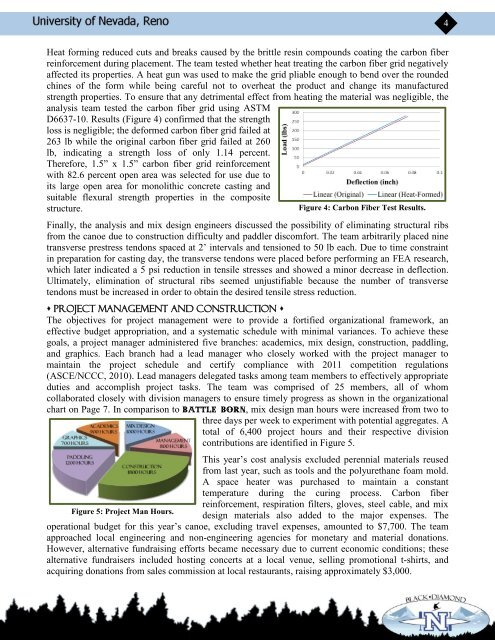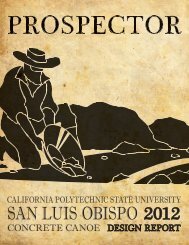Form Design Drawing - Concrete Canoe
Form Design Drawing - Concrete Canoe
Form Design Drawing - Concrete Canoe
Create successful ePaper yourself
Turn your PDF publications into a flip-book with our unique Google optimized e-Paper software.
Heat forming reduced cuts and breaks caused by the brittle resin compounds coating the carbon fiber<br />
reinforcement during placement. The team tested whether heat treating the carbon fiber grid negatively<br />
affected its properties. A heat gun was used to make the grid pliable enough to bend over the rounded<br />
chines of the form while being careful not to overheat the product and change its manufactured<br />
strength properties. To ensure that any detrimental effect from heating the material was negligible, the<br />
analysis team tested the carbon fiber grid using ASTM<br />
D6637-10. Results (Figure 4) confirmed that the strength<br />
loss is negligible; the deformed carbon fiber grid failed at<br />
263 lb while the original carbon fiber grid failed at 260<br />
lb, indicating a strength loss of only 1.14 percent.<br />
Therefore, 1.5” x 1.5” carbon fiber grid reinforcement<br />
with 82.6 percent open area was selected for use due to<br />
its large open area for monolithic concrete casting and<br />
suitable flexural strength properties in the composite<br />
structure.<br />
Figure 4: Carbon Fiber Test Results.<br />
Finally, the analysis and mix design engineers discussed the possibility of eliminating structural ribs<br />
from the canoe due to construction difficulty and paddler discomfort. The team arbitrarily placed nine<br />
transverse prestress tendons spaced at 2’ intervals and tensioned to 50 lb each. Due to time constraint<br />
in preparation for casting day, the transverse tendons were placed before performing an FEA research,<br />
which later indicated a 5 psi reduction in tensile stresses and showed a minor decrease in deflection.<br />
Ultimately, elimination of structural ribs seemed unjustifiable because the number of transverse<br />
tendons must be increased in order to obtain the desired tensile stress reduction.<br />
� Project management And Construction �<br />
The objectives for project management were to provide a fortified organizational framework, an<br />
effective budget appropriation, and a systematic schedule with minimal variances. To achieve these<br />
goals, a project manager administered five branches: academics, mix design, construction, paddling,<br />
and graphics. Each branch had a lead manager who closely worked with the project manager to<br />
maintain the project schedule and certify compliance with 2011 competition regulations<br />
(ASCE/NCCC, 2010). Lead managers delegated tasks among team members to effectively appropriate<br />
duties and accomplish project tasks. The team was comprised of 25 members, all of whom<br />
collaborated closely with division managers to ensure timely progress as shown in the organizational<br />
chart on Page 7. In comparison to Battle Born, mix design man hours were increased from two to<br />
three days per week to experiment with potential aggregates. A<br />
total of 6,400 project hours and their respective division<br />
contributions are identified in Figure 5.<br />
This year’s cost analysis excluded perennial materials reused<br />
from last year, such as tools and the polyurethane foam mold.<br />
A space heater was purchased to maintain a constant<br />
temperature during the curing process. Carbon fiber<br />
reinforcement, respiration filters, gloves, steel cable, and mix<br />
Figure 5: Project Man Hours.<br />
design materials also added to the major expenses. The<br />
operational budget for this year’s canoe, excluding travel expenses, amounted to $7,700. The team<br />
approached local engineering and non-engineering agencies for monetary and material donations.<br />
However, alternative fundraising efforts became necessary due to current economic conditions; these<br />
alternative fundraisers included hosting concerts at a local venue, selling promotional t-shirts, and<br />
acquiring donations from sales commission at local restaurants, raising approximately $3,000.<br />
4




